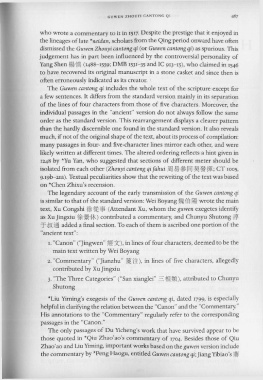Page 507 - The Encyclopedia of Taoism v1_A-L
P. 507
GUWEN ZHOUYI CANT O NG QI
who wrote a commentary to it in 1517. Despite the prestige that it enjoyed in
the lineages of late *neidan, scholars from the Qing period onward have often
dismissed the Guwen Zhouyi cantong qi (or Guwen can tong qi) as spurious. This
judgement has in part been influenced by the controversial personality of
Yang Shen m'tJ:! (1488- 1559; DMB 1531- 35 and IC 913-15), who claimed in 1546
to have recovered its original manuscript in a stone casket and since then is
often erroneously indicated as its creator.
The Guwen cantong qi includes the whole text of the scripture except for
a few sentences. It differs from the standard version mainly in its separation
of the lines of four characters from those of five characters. Moreover, the
individual passages in the "ancient" version do not always follow the same
order as the standard version. This rearrangement displays a clearer pattern
than the hardly discernible one found in the standard version. It also reveals
much, if not of the original shape of the text, about its process of compilation:
many passages in four- and five-character lines mirror each other, and were
likely written at different times. The altered ordering reflects a hint given in
1248 by *Yu Yan, who suggested that sections of different meter should be
isolated from each other (Zhouyi cantong qi fahui ftU £ ~ ~ ~~:f:!ll'; CT 1005,
9.19b-21a). Textual peculiarities show that the rewriting of the text was based
on *Chen Zhixu's recension.
The legendary account of the early transmission of the Guwen cantong qi
is similar to tha t of the standard version: Wei Boyang ft 18 ~ wrote the main
text, XU Congshi t%~$ (Attendant Xu, whom the guwen exegetes identifY
as XuJingxiu fi:l"1*) contributed a commentary, and Chunyu Shutong ¥¥
T;El( ~ added a final section. To each of them is ascribed one portion of the
"ancient text":
1. "Canon" ("Jingwen" ~~)() , in lines of four characters, deemed to be the
main text written by Wei Boyang
2. "Commentary" ( Jianzhu" flt±J, in lines of five characters, allegedly
contributed by XuJingxiu
3. "The Three Categories" ( San xianglei" = f§!liJi), attributed to Chunyu
Shutong
*Liu Yiming's exegesis of the Guwen can tong qi, dated 1799, is especially
helpful in clarifying the relation between the "Canon" and the "Commentary."
His annotations to the "Commentary" regularly refer to the corresponding
passages in the "Canon."
The only passages of Du Yicheng's work that have survived appear to be
those quoted in *Qiu Zhao'ao's commentary of 1704. Besides those of Qiu
Zhao' ao and Liu Yirning, important works based on the guwen version include
the commentary by *Peng Haogu, entitled Guwen can tong qi; Jiang Yibiao's ~

